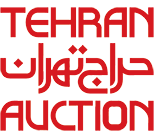Qollar-Aqsi is, without doubt, the most well-known artist of the Coffeehouse School of Painting. He along with Mohammad Modabber introduced a style into Iranian painting that at a time when modern art and the Kamal-ol-Molk School of Painting emerged, was the last style of popular, indigenous, and spontaneous painting.
In his epic religious designs, Qollar-Aqsi made use of oil painting and utilized his experiments with tile painting to achieve a style in which the Shahnama narratives and religious stories were combined with the realities in the mind of the artist and skillfully projected on canvas. At the same time, this method was indebted to the traditions of Persian painting. Application of shadows divorced his work from miniature painting, while absence of European perspective, distanced his art from Western landscape painting. The painting on display, partly combined with the imagination of the artist, narrates the story of Iranian heroes who defended Iran against the enemy. Following the tradition of the Coffeehouse School, Qollar-Aqsi has written in fine cursive calligraphic form the name of each character in the story next to his picture. The name of the commissioner, Akbar Davatgar, who used to commission a lot of such paintings, can be clearly seen at the bottom of the painting.
The painting does not seem to refer to any particular story in the Shahnama. Such inconsistency between the story and painting is common. It is also considered a strength for the Coffeehouse School paintings, as it renders an imaginary aspect to the work. In other words, it is the painter rather than the narrator who shapes the story in Coffeehouse paintings, hence the name “imaginary paintings”. The canvas is the breadth across which a painter can fly the bird of his imagination and direct the narrative.
The painting on sale narrates a story the plot of which can be speculated with some research and investigation. There are five major characters in the story, all celebrated heroes from Persia. A castle has also been depicted around which there is a moat full of water. As perspective in the tradition of Coffeehouse Painting comes in the form of “character perspective” with more important figures of the story in larger dimensions, it can be concluded that Houshang and Saam are superior to Fartous, Kaveh, and Gharen. The outfits indicate that the heroes are in a battlefield but no enemy can be seen in the picture. Young Houshang and Saam are depicted in the first and second pictures in war attire. Houshang seems to be planning to conquer the castle and contain the enemy when he is showered with large pieces of rock thrown from inside the castle. Houshang is hit by a piece and falls down. At this time, Saam rides in with a huge metal shield to protect Houshang from the rocks. In the second picture, three Iranian warriors riding on horses and ready to fight, are astounded by the bravery of Saam. Nearby tents indicate that troops are positioned a little further away behind the hills.
Qollar-Aqsi has successfully narrated the entire story in this composition. The depiction of the castle and the positioning of the three riders clearly demonstrate the influence of Persian painting on the work. Generous application of thick bright colors as well as fine details are other unique qualities of the work that display the work of a skilled


